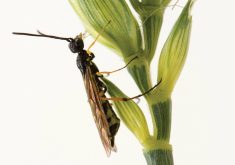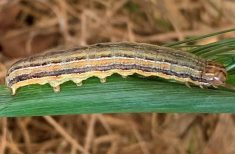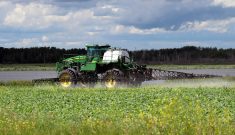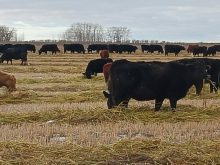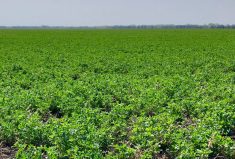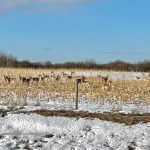Glacier FarmMedia — Prairie forage growers who plan to spray for a particular problem pest, but want to avoid collateral damage to more beneficial insects, may get their best and cleanest shot in the dark.
Forage and seed producers heard about the benefits of night spraying for red clover crops during the Saskatchewan Forage Seed Development Commission’s recent annual meeting. The SFSDC had conducted two on-farm experiments of night spraying in the province’s northeast in June 2021.
During the meeting, Graham Parsons, pollinator biosecurity specialist with the Saskatchewan agriculture department, identified the pollinators that benefit from nighttime pesticide application as farmers manage certain pests.
Read Also

Claas brings 1000 Series SP forage harvesters to Canada
In mid-August, Claas unveiled its new line of Jaguar forage harvesters at an event in Visalia, California, deep in the heart of that state’s dairy region.
The lesser clover leaf weevil “is more active in the night, in the canopy and stuff, so the spray actually for that pest was more effective during the night time as well,” he told the meeting at White Fox, north of Nipawin.
“So it’s kind of a win-win both ways: better for the pollinators and better for spraying for the pest as well.”
READ MORE: When a crop pest isn’t a crop pest
Producers are seeking ways to control the lesser clover leaf weevil. Management practices range from spring burning to encouraging parasitoids, but chemical application of pesticides has been the most effective.
Northeastern growers are under more pressure from the weevil, which lays eggs from May and into June and July when the crop starts to flower, according to a University of Saskatchewan study.

The commission said day and night spraying was done in June 2021 before clover flowering. Traps were set to identify the beneficial pollinators present in the field 24 hours before and after the spraying applications.
“Success then would be measured as ‘no decrease’ in trap catches for the 24 hours post-spray in relation to pre-spray samples, night spray compared to UTC (unsprayed treatment control)… there is no indication that night spraying was more deleterious to commercial or natural pollinators than day spraying,” the report said.
Parsons identified an abundance of bees in the traps. Bees of any kind are the gold standard of pollinators, he said. As for other pollinators, some moths fly at night but most require light and heat they can only get during the day.
“If you can spray at night or early in the morning, just as the sun comes up, or in the evening as the sun’s going down or after it’s gone down, then all the pollinators, they’re home for the night so they’re not going to be exposed to anything when you’re spraying,” Parsons says.

Protective predators
Hoverflies as pollinators have the added benefit of predatory larvae that attack various in-crop pests. However, hoverflies, wasps and some moths and butterflies are not as effective as bees at pollinating. The high number of hoverflies makes up for their lack of performance individually, he adds.
As a field crop entomologist with Agriculture and Agri-Food Canada, Tyler Wist has been an ardent supporter of predatory bugs through his Field Heroes program.
Farmers get both good pollinators and pest management with hoverflies, he said.
“When they’re in there pollinating the crop, they say ‘Hey, there’s some aphids here. I’m gonna lay some eggs and then have these little slug-like offspring that go around and stab aphids to death from their mouth parts, and then suck them dry.’ So super cool that they’re both.”
Bee flies and blister beetles are also predatory. Their larvae feast on grasshopper eggs, Wist says, so supporting their growth is beneficial.
Blister beetle adults can potentially eat leaves, so they’re not as beneficial as some other insect helpers. When they do get into the flower canopy, they are good cross pollinators and their damage is minimal compared to other harmful bugs, Wist says.
If farmers want to attract more beneficial insects, including different bee species, supporting their habitat is just as important as proper pesticide management, he says.
“Wild bees will nest in wooded areas and down in the ground too, so undisturbed ground areas are important for some of those ground nesting wild bees.”
Parsons has focused his research on pollinator habitat.
In a canola field without any wetlands, woodlands or edges, there is no habitat for pollinators, no matter how many flowers and forages there are.
“Most of our pollinators are nesting in the ground, about 70 per cent of them,” Parsons says. “So if there’s no (nearby) area that’s uncultivated … there’s no area for those bees to be nesting.”
Without wetland habitat, including willows, wildflowers or weeds, there is no food or places for insects to overwinter. By leaving the natural environment or planting permanent wildflower patches, producers can see benefits for a long time, Parsons says.
Depending on the crop and type of insects farmers are trying to keep in their fields, spray application timing and type can differ from crop to crop, Wist says.




